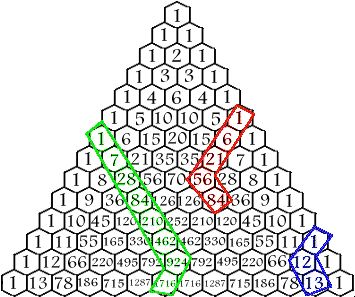$$\mathbf{12\binom{3}{3} + 11\binom{4}{3} + 10\binom{5}{3} + \cdots + 2\binom{13}{3} +\binom{14}{3} = \;?}$$
$$\small{\text{$
\begin{array}{l}
\mathbf{
12\binom{3}{3} +
11\binom{4}{3} +
10\binom{5}{3} +
9\binom{6}{3} +
8\binom{7}{3} +
7\binom{8}{3} +
6\binom{9}{3} +
5\binom{10}{3} +
4\binom{11}{3} +
3\binom{12}{3} +
2\binom{13}{3} +
1\binom{14}{3} } \\ \\
=
\mathbf{
\binom{4}{4} +
\binom{5}{4} +
\binom{6}{4} +
\binom{7}{4} +
\binom{8}{4} +
\binom{9}{4} +
\binom{10}{4} +
\binom{11}{4} +
\binom{12}{4} +
\binom{13}{4} +
\binom{14}{4} +
\binom{15}{4}
}\\\\
=
\mathbf{
\binom{16}{5}
}\\\\
=
\mathbf{
\dfrac{16!}{5!\cdot 11!}
}\\\\
=
\mathbf{
\dfrac{12\cdot 13\cdot 14\cdot 15\cdot 16}{5!}
}\\\\
=
\mathbf{
\dfrac{12\cdot 13\cdot 14\cdot 15\cdot 16}{1\cdot 2\cdot 3\cdot 4\cdot 5}
}\\\\
=
\mathbf{
\left(\dfrac{12}{3}\right)\cdot 13 \cdot
\left(\dfrac{14}{2}\right)\cdot
\left(\dfrac{15}{5}\right)\cdot
\left(\dfrac{16}{4}\right)
}\\\\
=
\mathbf{4 \cdot 13 \cdot 7 \cdot 3 \cdot 4}\\\\
=
\mathbf{13 \cdot 16 \cdot 21}\\\\
=
\mathbf{4368}
\end{array}
$}}$$
see Hockey Stick Pattern: http://ptri1.tripod.com/
| If a diagonal of numbers of any length is selected starting at any of the 1's bordering the sides of the triangle and ending on any number inside the triangle on that diagonal, the sum of the numbers inside the selection is equal to the number below the end of the selection that is not on the same diagonal itself. If you don't understand that, look at the drawing. 1+6+21+56 = 84 1+7+28+84+210+462+924 = 1716 1+12 = 13 |  |
![]()
$$\[\binom50+\binom51+\binom62+\binom71+\binom83+\binom92+\binom{10}4+\binom{11}3\] = 495$$
see: http://web2.0calc.com/#binom(5,0)+binom(5,1)+binom(6,2)+binom(7,1)+binom(8,3)+binom(9,2)+binom(10,4)+binom(11,3) and push the "=" Button
$$\small{\text{
$
\begin{array}{cccccccccccccccccccccccccc}
&&&&&&&&&&&\begin{pmatrix} 0\\0\end{pmatrix}=1\\
&&&&&&&&&&\begin{pmatrix} 1\\0\end{pmatrix}=1&&
\begin{pmatrix} 1\\1\end{pmatrix}=1\\
&&&&&&&&&\begin{pmatrix} 2\\0\end{pmatrix}=1&
&\begin{pmatrix} 2\\1\end{pmatrix}=2&
&\begin{pmatrix} 2\\2\end{pmatrix}=1\\
&&&&&&&&\begin{pmatrix} 3\\0\end{pmatrix}=1&&
\begin{pmatrix} 3\\1\end{pmatrix}=3&&
\begin{pmatrix} 3\\2\end{pmatrix}=3&&
\begin{pmatrix} 3\\3\end{pmatrix}=1\\
&&&&&&&\begin{pmatrix} 4\\0\end{pmatrix}=1&
&\begin{pmatrix} 4\\1\end{pmatrix}=4&
&\begin{pmatrix} 4\\2\end{pmatrix}=6&
&\begin{pmatrix} 4\\3\end{pmatrix}=4&
&\begin{pmatrix} 4\\4\end{pmatrix}=1\\
&&&&&&\begin{pmatrix} 5\\0\end{pmatrix}=1&&
\begin{pmatrix} 5\\1\end{pmatrix}=5&&
\begin{pmatrix} 5\\2\end{pmatrix}=10&&
\begin{pmatrix} 5\\3\end{pmatrix}=10&&
\begin{pmatrix} 5\\4\end{pmatrix}=5&&
\begin{pmatrix} 5\\5\end{pmatrix}=1\\
&&&&&\begin{pmatrix} 6\\0\end{pmatrix}=1&
&\begin{pmatrix} 6\\1\end{pmatrix}=6&
&\begin{pmatrix} 6\\2\end{pmatrix}=15&
&\begin{pmatrix} 6\\3\end{pmatrix}=20&
&\begin{pmatrix} 6\\4\end{pmatrix}=15&
&\begin{pmatrix} 6\\5\end{pmatrix}=6&
&\begin{pmatrix} 6\\6\end{pmatrix}=1\\
&&&&\begin{pmatrix} 7\\0\end{pmatrix}=1&&
\begin{pmatrix} 7\\1\end{pmatrix}=7&&
\begin{pmatrix} 7\\2\end{pmatrix}=21&&
\begin{pmatrix} 7\\3\end{pmatrix}=35&&
\begin{pmatrix} 7\\4\end{pmatrix}=35&&
\begin{pmatrix} 7\\5\end{pmatrix}=21&&
\begin{pmatrix} 7\\6\end{pmatrix}=7&&
\begin{pmatrix} 7\\7\end{pmatrix}=1\\
&&&\begin{pmatrix} 8\\0\end{pmatrix}=1&
&\begin{pmatrix} 8\\1\end{pmatrix}=8&
&\begin{pmatrix} 8\\2\end{pmatrix}=28&
&\begin{pmatrix} 8\\3\end{pmatrix}=56&
&\begin{pmatrix} 8\\4\end{pmatrix}=70&
&\begin{pmatrix} 8\\5\end{pmatrix}=56&
&\begin{pmatrix} 8\\6\end{pmatrix}=28&
&\begin{pmatrix} 8\\7\end{pmatrix}=8&
&\begin{pmatrix} 8\\8\end{pmatrix}=1\\
&&\begin{pmatrix} 9\\0\end{pmatrix}=1&&
\begin{pmatrix} 9\\1\end{pmatrix}=9&&
\begin{pmatrix} 9\\2\end{pmatrix}=36&&
\begin{pmatrix} 9\\3\end{pmatrix}=84&&
\begin{pmatrix} 9\\4\end{pmatrix}=126&&
\begin{pmatrix} 9\\5\end{pmatrix}=126&&
\begin{pmatrix} 9\\6\end{pmatrix}=84&&
\begin{pmatrix} 9\\7\end{pmatrix}=36&&
\begin{pmatrix} 9\\8\end{pmatrix}=9&&
\begin{pmatrix} 9\\9\end{pmatrix}=1\\
&\begin{pmatrix} 10\\0\end{pmatrix}=1&
&\begin{pmatrix} 10\\1\end{pmatrix}=10&
&\begin{pmatrix} 10\\2\end{pmatrix}=45&
&\begin{pmatrix} 10\\3\end{pmatrix}=120&
&\begin{pmatrix} 10\\4\end{pmatrix}=210&
&\begin{pmatrix} 10\\5\end{pmatrix}=252&
&\begin{pmatrix} 10\\6\end{pmatrix}=210&
&\begin{pmatrix} 10\\7\end{pmatrix}=120&
&\begin{pmatrix} 10\\8\end{pmatrix}=45&
&\begin{pmatrix} 10\\9\end{pmatrix}=10&
&\begin{pmatrix} 10\\10\end{pmatrix}=1\\
\begin{pmatrix} 11\\0\end{pmatrix}=1&&
\begin{pmatrix} 11\\1\end{pmatrix}=11&&
\begin{pmatrix} 11\\2\end{pmatrix}=55&&
\begin{pmatrix} 11\\3\end{pmatrix}=165&&
\begin{pmatrix} 11\\4\end{pmatrix}=330&&
\begin{pmatrix} 11\\5\end{pmatrix}=462&&
\begin{pmatrix} 11\\6\end{pmatrix}=462&&
\begin{pmatrix} 11\\7\end{pmatrix}=330&&
\begin{pmatrix} 11\\8\end{pmatrix}=165&&
\begin{pmatrix} 11\\9\end{pmatrix}=55&&
\begin{pmatrix} 11\\10\end{pmatrix}=11&&
\begin{pmatrix} 11\\11\end{pmatrix}=1
\end{array}
$}}$$
$$\small{\text{
$
\binom50+\binom51+\binom62+\binom71+\binom83+\binom92+\binom{10}4+\binom{11}3= 1+5+15+7+56+36+210+165 = 495
$}}$$
![]()